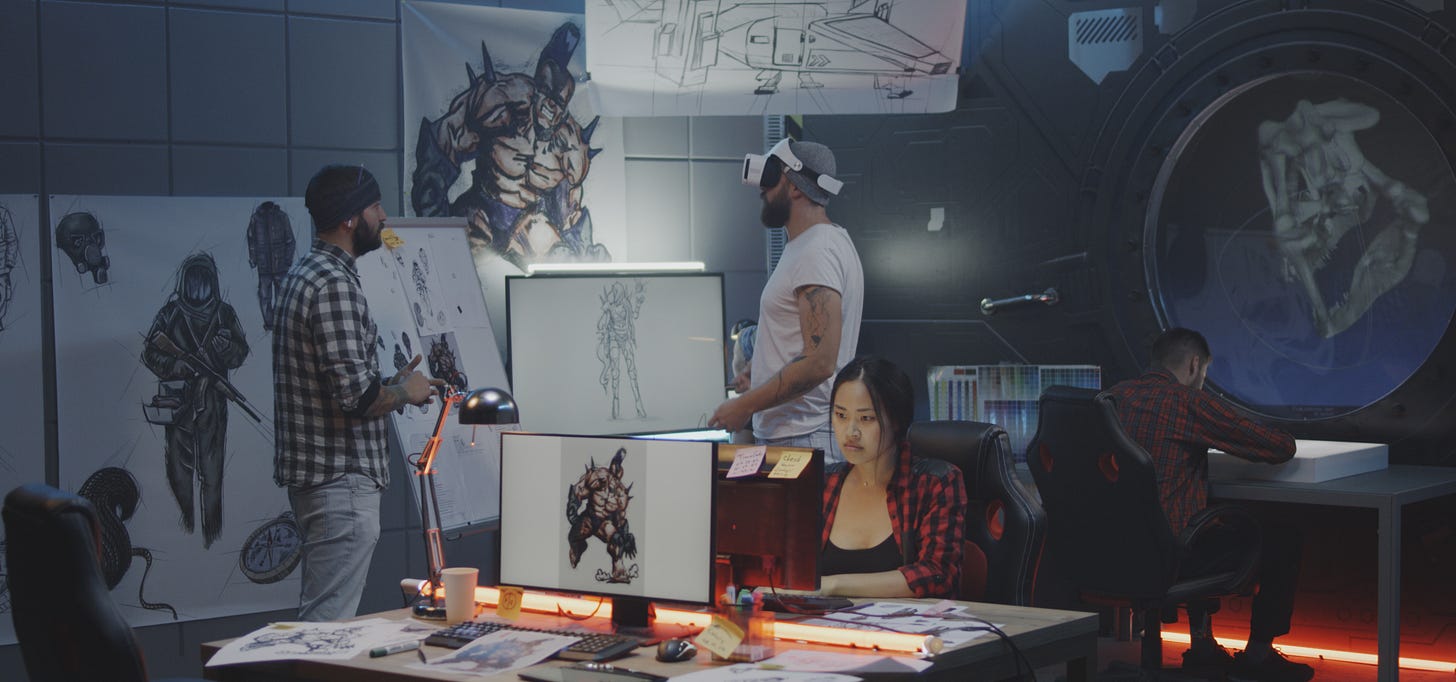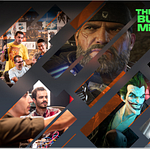Listen now on Apple, Spotify or YouTube
In This Edition
- The geographical shift in video game jobs
- Is AI a threat?
- The decline of remote working
- Unions, Nintendo and opportunities
Hello! Welcome to Episode 50 of The Game Business!
If you’ve yet to fill in our reader survey, please do. We would love your thoughts on how you’re reading/listening/viewing us. And also, we’d like to hear where you think we should head next. It should only take a minute. You can do so through here.
Today, it’s a bit of a different Show to our usual Thursday News Show. We’ve been joined by Amir Satvat, the Tencent exec who has made a name for himself via the Amir Satvat’s Games Community, a completely free resource designed to help people looking for jobs in video games. He even picked up the inaugural Game Changer award at The Game Awards for the project.
Satvat has collected a huge amount of information on the video game jobs market. He’s tracked tens of thousands of applicants, covered thousands of studios, and built a network of 2,500 people who have conducted 75,000 mentoring, CV review, mock interview and other advisory conversations. In total, his work has helped 4,000 people find employment.
So, we had a chat with Satvat to discuss his data, to see where the jobs market is shifting, and ask what hope there is for those looking for video game jobs in 2025.
You can check out the full interview above, or read my edited highlights below.
More than 50% of jobs lost in video games were in California
Your view on the severity of the video game job losses will depend a bit on where you are based.
Amir Satvat told The Game Business that North America is, by far, the hardest hit area when it comes to job cuts. But there are parts of the world that are actually seeing growth.
“Over 70%, and in some years 75%, of the layoffs have been in North America,” Satvat shared. “North America used to have 30%, 35%, 40% of the open roles, and that number is now down to 25%. Overall employment in the industry has actually increased since pre-COVID. But if you're in North America in a AAA studio, you're like, ‘what are you talking about? The workforce is cut by 15% to 20%’. Versus if you're in a studio in Asia you’re like, ‘What are you talking about? We’ve seen an increase in jobs’.”
“And here’s another stat, over 50% of the cuts globally have been in California. California AAA is like the epicenter of the difficulty.”
As a result, Satvat said flexibility is key to finding work in games.
“There is opportunity, but it may be that if you want to stay in the industry, being open to going to some of these places like China, like Japan, not forever, but for some amount of time, that's going to become a larger part of the equation.”
Remote job vacancies have fallen sharply
The ability to move locations is made all the more important by the drop in work-from-home roles.
Satvat started tracking jobs in mid-2022, and back then 25% to 30% of open roles were ‘remote’. Now, that number sits between 10% and 13%.
One popular topic today is around game companies increasingly using contractors and freelancers, instead of making full hires. But Satvat is wary of recommending this direction for job seekers, because despite the talk, he has seen a drop in the percentage of advertised freelance roles.
“Now, I don't know if necessarily there's things that I can't see or observe, but I can tell you for open roles, that is not a phenomenon,” he said.
Sponsor Message:
From Keywords Studios. If you’ve played a game, streamed a show, or helped make one - you’ve likely experienced our work.
Keywords Studios are the No.1 technical and creative solutions partner to the global video games industry.
We partner with indie creators, AAA studios, global publishers, and streaming platforms to bring ideas to life through:
Game Development
Art
Audio
Localization
Marketing Services
Sentiment Analytics
Player Engagement
Media & Entertainment
Consultancy Solutions
An end-to-end partner supercharged by proprietary technology, with 13,000 experts across every time zone powering some of the world’s biggest IPs.
More insights, more solutions, more impact.
Fan-first. Always.
Imagine More.
It’s a really tough market for young people, older people and writers
Here are some unsettling statistics.
New people looking to get into games, with less than three years of work experience, have between a 5% and 7% chance of finding a job in games
For everybody, that number is 15%. For games veterans, that goes up to 30% - 35%
But for people over 50 years-old, the percentage goes back to between 5% and 7%
When it comes to job function, the ‘easiest’ roles to get are in engineering and programming
But, if you’re interested in game design, your odds are nine times tougher
If you’re someone in writing or narrative, your odds are 22 times tougher
“I've been pushing what I call ‘Project Reality’, which is about getting games people to focus on looking for non-game roles,” Satvat said.
“I actually think of people like concentric circles. Are they one circle away from games? Or two circles? Even three circles away? One circle away would be… you were at Amazon in the studio, now you're at Prime Video. Two circles would be even further away from that. We now have more placements for our community in non-game than in games.
“We know 85% of [people looking for game jobs] are going to have to find non-game jobs. So, it's been a slow, empathetic process of trying to get people to understand that they simply have to look at other stuff. It's just mathematically not possible otherwise. Not forever, but for some amount of time.”
“We know 85% of [people looking for game jobs] are going to have to find non-game jobs”
… but there are opportunities
Talking about the job situation in video games is inevitably a bleak topic. But it wasn’t all doom and gloom.
One part of the industry that is growing, Satvat said, is in co-development and ex-development. There have been some recent reductions at companies like Sumo Digital and Virtuos but, overall, there has been growth.
Yet he also sees a shift in the overall business that presents opportunities, albeit these opportunities do require specific skillsets.
“The games market is absolutely growing and has a lot of room to grow,” he insisted. “I really think it's going to be the dominant interactive and entertainment medium of the next century, unless something significant changes.
“It's very encouraging that indies, which used to be only 10% to 20% of the Top 25 Metacritic games 20 to 30 years ago, are now perennially 50% to 70% of the top Metacritic games. I feel like it is easier than ever to self-start, to self-publish, to make your own game, to make your own mods, to learn what to do. Everything is growing, everything is more open, and people still love games… but it just takes a very different entrepreneurial skillset to take that on.
“If what you're looking for is the 20-year, AAA standard functional gig in one location, that's going to be an expectation set that's hard to meet increasingly and may disappoint. But I feel like if you go into it open… it's still very, very tough, but there are opportunities that didn't exist before.”
Satvat is pragmatic about the AI ‘threat’
One looming concern about the future of video game jobs is around AI.
Satvat said there are four primary things companies are doing to get costs down. They’re increasingly moving jobs geographically, they’re using more external development partners (often in cheaper locations), they’re looking into making smaller projects with smaller teams. And then comes AI. So, is it a threat to jobs?
“I think it is, but I don't know to what extent. I'm not a technical expert on AI. If you look at roles that actually have AI in the title, like an AI engineering or AI art role, or it appears heavily in the job description, I found that it had grown, but only modestly, like from 3% to 6% of roles.”
I told Satvat about meeting a 12-year-old relative over Christmas, who had made a Wipeout-style racing game. He programmed the title himself, and used AI artwork for the rest. I was both impressed and terrified to see what a young person had been able to create in just a few months by himself.
“I am not a pro-AI person, but out of pragmatism, this thing that I'm sure you've heard many people say is: you shouldn't be afraid of AI taking your job, but someone using AI, and taking your job over you,” he said.
“I've been trying to encourage the community to at least understand what these things are, to be prepared. But I am empathetic that, for some in the community, this is so abhorrent that even talking about it or engaging with it is a non-starter. I don't quite share that view because the most important thing to me is keeping our community employed, which is why I think they should at least know what the tools are. But I can understand that some would criticize me and say, ‘Oh, Amir, even that's the wrong view. It should just be opposition the whole way’.”
Unions are not a panacea for corporate layoffs
Another trend in the video game labor market is the rise of unions, and I wanted Satvat’s view on how that is impacting jobs and lay-offs in the video game space.
“I don't have enough of an observation or size to comment on the impact that that has,” he said.
“Anecdotally, I have observed that in situations where people have unions, they tend to shake out with better outcomes that those that don't. My personal opinion… I am in support of unions and generally believe that in the right context they can be very beneficial. But I am always cautious as advertising them as a panacea, only because as someone who studied public policy in graduate school, I know of too many situations where in environments that are non-union supported, particularly in situations where people are geographically shifting labor, even having unions in place sometimes doesn't protect staff.”
The global video game industry could learn from Nintendo
Towards the end of our conversation, the topic of Nintendo came up.
There’s that famous moment during the Wii U era when Nintendo decided to cut management salaries instead of staff when it ran into financial difficultly. But I also brought up why Nintendo is often reluctant to buy companies. The platform holder’s position is that a company is a collection of people, and people can just leave. Therefore, buying a studio is a risky investment, particularly as the leadership team are likely to depart shortly after the acquisition.
“I do put Nintendo on a pedestal, while acknowledging that they, like any organization, have imperfections,” Satvat concludes. “And certainly they've had situations where they've had cuts too. I can't pretend that has never happened.
“But the fact of the matter remains, in addition to the many good things that you said, they have an outrageously high percentage of staff retention, and they have executives who are paid 1950s America-levels of compensation relative to lowest paid staff, like 20 times, 30 times… not 400 times.
“There's a lot of things about processes and values within not only them, but Japanese business culture as well, which is not perfect. Nothing is perfect. But… I love a lot of things about our [US] entrepreneurial spirit and creativity, but [Japanese companies] certainly have a lot of great things that we could learn from.”
Meanwhile…
007: First Light is coming out March 27, 2026. I saw the game at Gamescom and it’s looking great.
According to Bloomberg, Take-Two considered funding and publishing the Perfect Dark reboot that Microsoft cancelled in July. However, the companies couldn’t agree terms on the long-term ownership of the IP. The Game Business understands that nearly a third of the game’s costs (around $80 million) still needed to be spent to get the title to completion.
Capcom is concerned about the barrier-to-entry of consoles. In an interview with Nikkei Gaming, Capcom president Haruhiro Tsujimoto discussed the high price of games, hardware and subscriptions as making it harder for the publisher to reach younger audiences on devices such as PS5
Paramount has scored a coup by inking a deal with Activision to produce a live-action Call of Duty movie. Paramount CEO David Ellisson said the opportunity is “an honor and responsibility that we don’t take lightly”.
Games distributor Curveball Leisure has launched a publishing division called Curveball Games. The new full-service publisher is led by former PlayStation and PQube exec Ed Gregory.
CD Projekt says that 75% of sales for Cyberpunk 2077 on Switch 2 was of the physical version (these are shipment numbers). Nintendo Switch was always a heavily physical platform, and Switch 2 appears (at least initially) to continue that.
Thunderful shareholders have agreed to Atari becoming the firm’s majority shareholder. The retro games specialist now owns 82% of the Swedish game publisher.
Roblox will expand its age estimation requirements to all users. The firm introduced new safety features in July, which included using AI to estimate a player’s age through a selfie. In the future, this will be done via a combination of age estimation, ID verification and verified parental consent.
Finally, Game of Thrones star Sophie Turner is the latest person to take on the role of Lara Croft. She will play the character in the upcoming Amazon-produced Tomb Raider TV show. Fleabag writer Phoebe Waller-Bridge will service as series writer, executive producer, co-showrunner and creator.
That’s it for today’s episode. Our usual news show will return next week. Thank you for reading (and please do fill in our survey).















